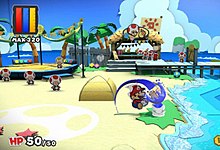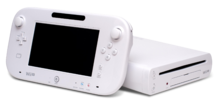Paper Mario: Color Splash
Paper Mario: Color Splash[a] is a 2016 role-playing video game developed by Intelligent Systems and published by Nintendo for the Wii U console.
The story follows Mario and his new ally Huey on a quest to save Prism Island and rescue Princess Peach from Bowser.
Players control Mario as he traverses levels made to look like craft materials, reaching endpoints and retrieving each Big Paint Star through linear gameplay.
The development team focused on puzzle-solving and comedic elements, and to make each game different from one another, emphasized an overarching gimmick.
The paint theme was conceived by Atsushi Isano, the director for Intelligent Systems, and developed to take advantage of the Wii U GamePad.
[9] The main objective is to retrieve the missing six Big Paint Stars stolen by Bowser, all of which occupy a different portion of the world.
[10] Players traverse through a world map containing stages; the goal of each is to reach the Mini Paint Star at the end.
[9] In these stages, Mario can collect items and coins, talk to non-player characters (NPC), and complete puzzles and platforming challenges.
[10] To use the ability, the player traces a dotted line on the GamePad's touchscreen, causing part of the environment to peel off, exposing secrets and new areas.
[14] They range from basic jump and hammer attacks to "Thing" cards that resemble real-world objects, such as a fire extinguisher.
As Mario collects the Big Paint Stars, each one incrementally tells the duo about their memories of an attack on Port Prisma.
Once Mario recovers all six Big Paint Stars, they learn that Bowser attempted to dye his shell a rainbow color using the Prisma Fountain but inadvertently mixed all the colors together creating black paint, a toxic substance that possessed him and transformed him into "Black Bowser".
He proceeded to summon his army to steal the Big Paint Stars and drain the color from Prism Island.
The duo defeat Black Bowser, rescue Peach, and destroy the factory; that destruction causes the castle to fall apart in the process.
Peach, Mario, and Luigi escape, but Huey stays to stop the black paint and absorbs the castle.
Due to the poor reception of the previous game, Paper Mario: Sticker Star, Nintendo kept its negative feedback in mind during the development process.
[16] Producer Kensuke Tanabe explained that the idea of repainting the world originally came from director of production Atsushi Ikuno in 2012.
[17] Former Nintendo CEO Satoru Iwata suggested that the philosophy of development was to limit options to help bring out more creativity.
However, it was quickly discovered Nintendo of America had accidentally made the full game available two weeks before its intended launch date.
[23] Nintendo later pulled the pre-load option from the North American eShop, but people who downloaded the game were able to keep their copies.
[29] Nintendo Life's Conor McMahon considered the writing to be a major increase in quality in comparison to Sticker Star, saying that the "scenes and interactions brim with humour, charm and imagination, making it an absolute joy to discover new people and places as you progress.
[9] Terry Schwartz of IGN called Huey "endearing" and became emotionally attached to the character as the game progressed.
[30] Jones called the visuals of Color Splash "the purest distillation of the original Paper Mario style yet".
[30][9] Although Jason Hidalgo, writing for the Reno Gazette-Journal, found the new gameplay features to be a well-functioning and purposeful addition, they felt they would come off as too difficult to use for younger audiences.
[9] McMahon and VentureBeat's Dennis Scimecaen considered the battle difficulty to be too low and tedious to hold interest.
[15] Ryckert commented that "just about everything in Color Splash is instantly likable", but felt that the combat phases dragged down the experience.
"[31] Commenting on Thing cards, Jones and Scimecaen enjoyed how they brought a unique way of defeating enemies, although backtracking to find them became increasingly frustrating.
[9][12] Much like Sticker Star reception, reviewers compared Color Splash negatively to the first games in the series, Paper Mario (2000) and The Thousand-Year Door (2004), due to the loss of RPG elements.
They still reminisced on old characters from the series in comparison to Huey, however, and called the new take on combat "more of a chore for players rather than a pleasure".


